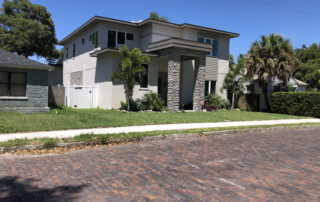Although you may not think much about the roof line of your residential home or commercial business, the type of roof on the building makes a big difference.
Not only will the type of roof largely define the aesthetic look of the building, but each type of roof has its own benefits and drawbacks – from maintenance to longevity. If you are thinking of adding a new roof to your building and are wondering if there is a difference between a pitched or flat roof, we are here to help.

Flat Roof – Definition and Attributes
Although a common term, there is not really any such thing as a “flat roof” – or at least you shouldn’t want one! Your roof should always have a slight slope so that the water can drain off the roof – so in reality, your flat roof is a low-slope roof. Still, it does appear flat and the slope is not generally noticeable.
Did You Know? The slope is measured by the roof fall over 12 inches. For instance, if there is a one-inch fall over twelve inches, that is known as a 1 and 12; while a three-inch fall is known as a 3 and 12. Everything under a 3-inch fall is considered a low slope (flat) roof.
A flat roof cannot be constructed with shingles, rather is fabricated with some type of membrane material designed to keep any standing water from resulting in a leak. However, flat roofs are known to leak more than sloped roofs. You want to make sure that your flat roof is draining properly, both to prevent leaks as well as to avoid structural damage which can occur due to the weight of standing water.
If you see excessive ponding on the roof, have a roofing contractor check the integrity of the underlayment, insulation and roof structure to make sure the slope is correct and the water can drain.
On the positive side, flat roofs are excellent in industrial situations, as air handlers or other equipment can be stored on the roof, and are easily reached by workers. Flat roofs are generally easier and safer to walk on and do not catch the wind in major storms like a sloped roof may.
Sloped or Pitched Roof – Attributes
Any roof with a roof fall of 4 and 12 or above is considered a pitched roof. These roofs are generally cheaper to install than a flat roof, as shingles are more affordable than the required flat-roof membranes. Because water runs off the roof naturally, a pitched roof is also susceptible to less leaking.
There is some discussion as to the correct pitch for a residential roof. You will want a pitch which sheds water well, provides good roof overhangs and can be more easily walked on (for maintenance and repair). While some roofing contractors feel that 5 and 12 is the perfect slope for all of these factors, your home may require a different pitch. This is where the valuable advice of a local Venice roofing contractor comes in.
Regardless of if you choose a flat roof or pitched roof, the complexity of the roof line should always be considered. A simple roofline with few protrusions will have less opportunity to leak, while a roof with skylights, vents, ducts, or industrial equipment is far more likely to cause problems. When choosing a roof style for your home, remember that from a maintenance perspective, simplicity is key.
The experts at [company_name] have been repairing roofs in the Venice area for years, and we have experience in both commercial and residential properties. If you have any questions regarding which type of roof is right for you, just give us a call, We will be happy to come out and speak with you as to our professional recommendations.


